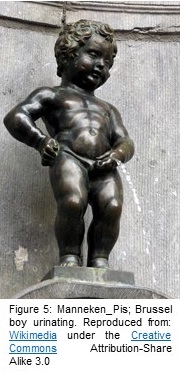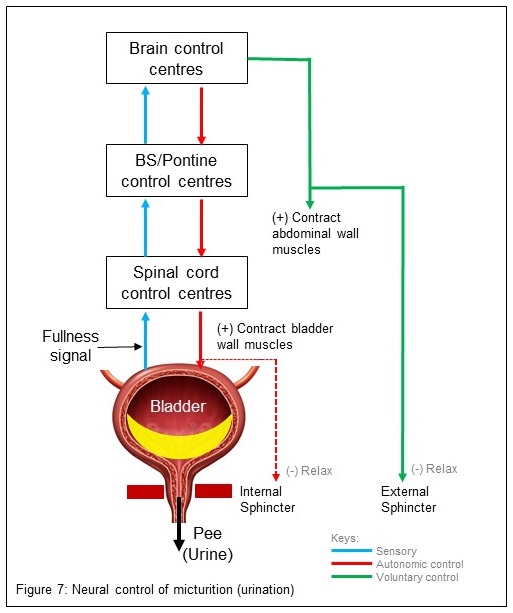By Chinedu Akpa. B. Pharm. Freelance Health Writer and DLHA Volunteer. Medically reviewed by the DLHA Team
.jpg)
Views of the kidney
 Urinating is a basic function that people carry out multiple times a day (figure 5). In normal conditions, it takes little effort to do and taken for granted. However, for people with diverse urinary problems including chronic kidney disease (CKD), this function is not as straightforward as it might seem.
Urinating is a basic function that people carry out multiple times a day (figure 5). In normal conditions, it takes little effort to do and taken for granted. However, for people with diverse urinary problems including chronic kidney disease (CKD), this function is not as straightforward as it might seem.
The basic functions of the kidney are to:
The kidney achieves its functions through these three basic processes of the nephron:
Because the kidney receives a large amount of blood (roughly 22%) from the heart's pumping action, it has the capacity to filter large amounts of blood. It is important to remember that the kidney's main job is to filter blood and produce urine. [8] The blood is filtered in the glomerulus, a network of microscopic blood vessels known as capillaries. These capillaries have complex microstructures made up of different specialised cells. Only the appropriate materials are allowed to pass through the glomerulus thanks to the barrier that these cells create, acting as a sort of sieve. [9]
Water, urea, glucose, amino acids, and mineral ions from the blood are among the substances that are permitted to pass through the glomerulus to form the first filtrate, which is typically collected in the Bowman's capsule (see stage 1 in figure 6). [9]
Figure 6: The nephron showing details of its three basic processes and where they happen.
The first filtrate leaves the Bowman's capsule and travels to the Proximal Convoluted Tube (PCT), a section of the nephron. The majority of the substances that were filtered into the Bowman's capsule are reabsorbed into the bloodstream at the PCT site (see stage 2 in figure 6). At this location, it is thought that between 60 and 65 percent of filtered salt (sodium chloride) returns to the bloodstream in combination with other substances. The filtrate at this location also contains some waste products and toxins that are secreted. [10]
The sequence of events moves from the PCT to the Loop of Henle, another nephron site where the residual 30–40% of filtered salt is reabsorbed with water, thereby concentrating the urine (see stages 3 and 4 in figure 6). [10] The next locations where reabsorption occur are the Distal Convoluted Tube (DCT) and Collecting Ducts (CD) (see stages 5 and 6 in figure 6). The DCT contributes about 5-10% to the reabsorption of filtered sodium chloride. It fine tunes the urine while it is being collected into the CD. [10]
The kidneys require the pressure created by the heart's pumping action in order to function correctly and survive, but they also assist in keeping blood pressure in check because either too high or too low blood pressure can be harmful to them. A case of I scratch your back and you scratch mine.
By regulating the amount of water and sodium in the blood at any given moment, the kidneys contribute to controlling blood pressure. Consuming more sodium and water will cause the blood volume to rise, which will increase the volume of blood that the veins must return to the heart in order for it to receive oxygen. When this occurs, the heart's chamber, like the atrium, expands, raising the heart's output and, ultimately, blood pressure. [11]
Water and Body Chemical Balance
The kidney maintains body balance by increasing the amount of water and sodium excreted and decreasing the amount reabsorbed in response to an increase in atrial pressure. [11] Aldosterone is a hormone that the kidney needs in order to perform this specific function. [12]
Talking about the aldosterone, this important hormone also plays an important role in regulating electrolytes like sodium, calcium, bicarbonates, and potassium. It also contributes to the pH balance (acid-base). All of this is made possible by aldosterone's ability to attach itself to parts of the nephron that are sensitive to aldosterone, such as the collecting duct system and DCT. Ion channels can be regulated by this hormone at these locations.[12]
The stages of urine formation are filtration, reabsorption, and secretion as explained above and illustrated in figure 6. These processes end in the Distal convoluted tubules (DCT) and Collecting ducts (CD). The components of urine are wastes, drugs and their by-products (which explains why urine samples are occasionally used in doping tests), ammonia, creatinine, and excess ions secreted at these sites. [13]
Each phase of the urine formation faces potential threat of disruption which can ultimately cause blockage in urine function. While some of these threats can be prevented, others can't.
The urine of a healthy individual should not contain certain substances in detectable amounts, as their presence may suggest kidney or systemic problems as detailed:
 Urination removes wastes and toxins that have been filtered by the kidney out of the body. The urination impulse requires a complex network of signals between the nervous system, the bladder and related structures. The urine formed by the kidney is stored in the bladder (see figure 7). It is held up in the bladder until there is a need to pee.
Urination removes wastes and toxins that have been filtered by the kidney out of the body. The urination impulse requires a complex network of signals between the nervous system, the bladder and related structures. The urine formed by the kidney is stored in the bladder (see figure 7). It is held up in the bladder until there is a need to pee.
The timing of your urination is regulated by the brain, spinal cord and nerves in the bladder working together. The signal to pee arises from the bladder, travels through the spinal cord to a particular area of the brain called the brainstem, or the lower part of the brain, known as the PMC (pontine micturition center). [16]
The spinal cord in turn transmits signals from the PMC when it is activated to the bladder and the urethra. The urethra is the tube through which urine flows out from the bladder. The muscles around the upper part of the urethra, which work as stopcock, are first relaxed by these signals to make room for urine to pass through. The bladder also receives signals to contract more (tighten) a few seconds later, which increases pressure and forces pee out. [16]
Additional reflexes are triggered as the urine passes through the urethra, assisting in ensuring that the bladder empties fully. [16]
Conditions such as urinary tract infections, nerve damage (neuropathy), kidney stones, and prostate enlargement can affect this process.
The kidney filters blood, regulates electrolytes, and maintains blood pressure. It begins development after fertilization, with potential genetic and environmental disruptions. Positioned near the spine, kidneys contain nephrons responsible for filtration, reabsorption, and secretion. Disorders like CKD, hypertension, and diabetic nephropathy can impair these functions, affecting overall health.
← The Kidney: Structure and Blood Supply
1. Reidy KJ, Rosenblum ND. Cell and molecular biology of kidney development. Semin Nephrol. 2009 Jul;29(4):321-37. doi: 10.1016/j.semnephrol.2009.03.009.. Available from here.
2. Rehman S, Ahmed D. Embryology, Kidney, Bladder, and Ureter. [Updated 2023 Aug 8]. In: StatPearls [Internet]. Treasure Island (FL): StatPearls Publishing; 2024 Jan-. Available from here.
3. Soriano RM, Penfold D, Leslie SW. Anatomy, Abdomen and Pelvis: Kidneys. [Updated 2023 Jul 24]. In: StatPearls [Internet]. Treasure Island (FL): StatPearls Publishing; 2024 Jan-. Available from here.
4. Preuss HG. Basics of renal anatomy and physiology. Clin Lab Med. 1993 Mar;13(1):1-11. Available from here.
5. Chade AR. Renal vascular structure and rarefaction. Compr Physiol. 2013 Apr;3(2):817-31. doi: 10.1002/cphy.c120012. Available from here.
6. Leslie SW, Sajjad H. Anatomy, Abdomen and Pelvis, Renal Artery. [Updated 2023 Aug 8]. In: StatPearls [Internet]. Treasure Island (FL): StatPearls Publishing; 2024 Jan-. Available from here.
7. Bowdino CS, Owens J, Shaw PM. Anatomy, Abdomen and Pelvis, Renal Veins. [Updated 2023 Jan 2]. In: StatPearls [Internet]. Treasure Island (FL): StatPearls Publishing; 2024 Jan-. Available from here.
8. Murray IV, Paolini MA. Histology, Kidney and Glomerulus. [Updated 2023 Apr 17]. In: StatPearls [Internet]. Treasure Island (FL): StatPearls Publishing; 2024 Jan-. Available from here.
9. Scott RP, Quaggin SE. Review series: The cell biology of renal filtration. J Cell Biol. 2015 Apr 27;209(2):199-210. doi: 10.1083/jcb.201410017. Available from here.
10. Madrazo-Ibarra A, Vaitla P. Histology, Nephron. [Updated 2023 Feb 17]. In: StatPearls [Internet]. Treasure Island (FL): StatPearls Publishing; 2024 Jan-. Available from here.
11. Van Beusecum J, Inscho EW. Regulation of renal function and blood pressure control by P2 purinoceptors in the kidney. Curr Opin Pharmacol. 2015 Apr;21:82-8. doi: 10.1016/j.coph.2015.01.003. Epub 2015 Jan 20. Available from here.
12. Scott JH, Menouar MA, Dunn RJ. Physiology, Aldosterone. [Updated 2023 May 1]. In: StatPearls [Internet]. Treasure Island (FL): StatPearls Publishing; 2024 Jan-. Available from here.
13. Ogobuiro I, Tuma F. Physiology, Renal. [Updated 2023 Jul 24]. In: StatPearls [Internet]. Treasure Island (FL): StatPearls Publishing; 2024 Jan-. Available from here.
14. Kazi AM, Hashmi MF. Glomerulonephritis. [Updated 2023 Jun 26]. In: StatPearls [Internet]. Treasure Island (FL): StatPearls Publishing; 2024 Jan-. Available from here.
15. Keefe P, Bokhari SRA. Fanconi Syndrome. [Updated 2023 Jul 4]. In: StatPearls [Internet]. Treasure Island (FL): StatPearls Publishing; 2024 Jan-. Available from here.
16. Fowler CJ, Griffiths D, de Groat WC. The neural control of micturition. Nat Rev Neurosci. 2008 Jun;9(6):453-66. doi: 10.1038/nrn2401. Available from here.
Published: September 14, 2024
© 2024. Datelinehealth Africa Inc. All rights reserved.
Permission is given to copy, use and share content freely for non-commercial purposes without alteration or modification and subject to source attribution
DATELINEHEALTH AFRICA INC., is a digital publisher for informational and educational purposes and does not offer personal medical care and advice. If you have a medical problem needing routine or emergency attention, call your doctor or local emergency services immediately, or visit the nearest emergency room or the nearest hospital. You should consult your professional healthcare provider before starting any nutrition, diet, exercise, fitness, medical or wellness program mentioned or referenced in the DatelinehealthAfrica website. Click here for more disclaimer notice.